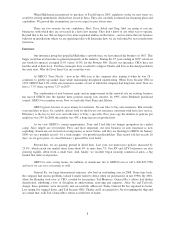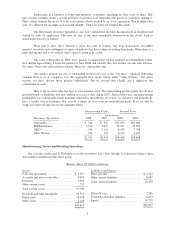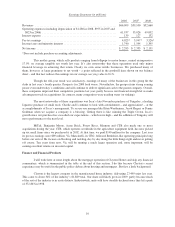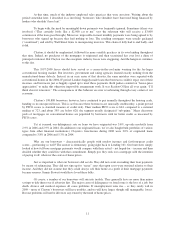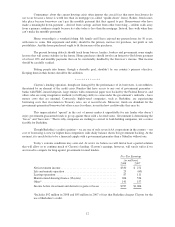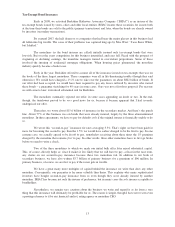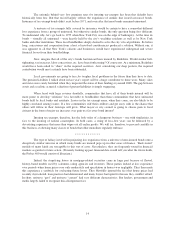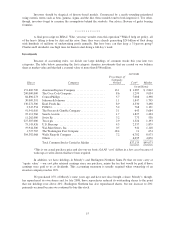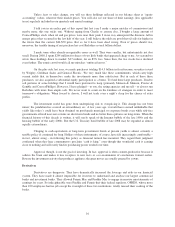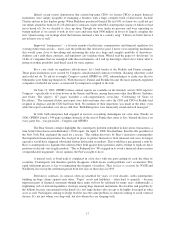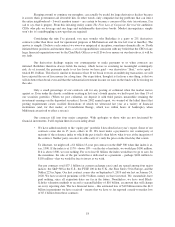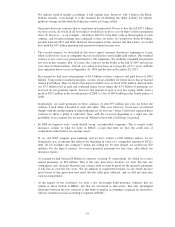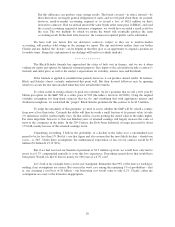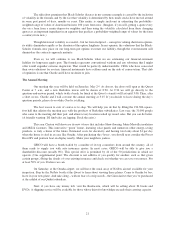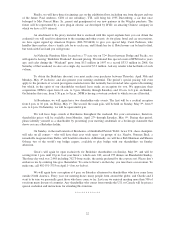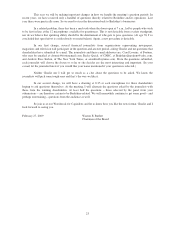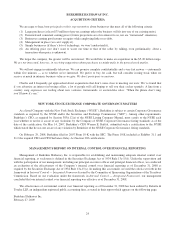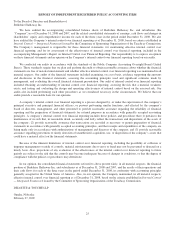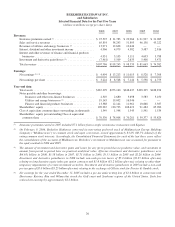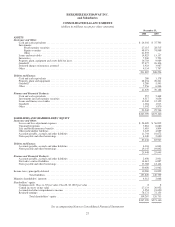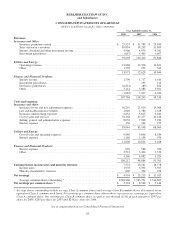Berkshire Hathaway 2008 Annual Report Download - page 20
Download and view the complete annual report
Please find page 20 of the 2008 Berkshire Hathaway annual report below. You can navigate through the pages in the report by either clicking on the pages listed below, or by using the keyword search tool below to find specific information within the annual report.Sleeping around, to continue our metaphor, can actually be useful for large derivatives dealers because
it assures them government aid if trouble hits. In other words, only companies having problems that can infect
the entire neighborhood – I won’t mention names – are certain to become a concern of the state (an outcome, I’m
sad to say, that is proper). From this irritating reality comes The First Law of Corporate Survival for ambitious
CEOs who pile on leverage and run large and unfathomable derivatives books: Modest incompetence simply
won’t do; it’s mindboggling screw-ups that are required.
Considering the ruin I’ve pictured, you may wonder why Berkshire is a party to 251 derivatives
contracts (other than those used for operational purposes at MidAmerican and the few left over at Gen Re). The
answer is simple: I believe each contract we own was mispriced at inception, sometimes dramatically so. I both
initiated these positions and monitor them, a set of responsibilities consistent with my belief that the CEO of any
large financial organization must be the Chief Risk Officer as well. If we lose money on our derivatives, it will be
my fault.
Our derivatives dealings require our counterparties to make payments to us when contracts are
initiated. Berkshire therefore always holds the money, which leaves us assuming no meaningful counterparty
risk. As of yearend, the payments made to us less losses we have paid – our derivatives “float,” so to speak –
totaled $8.1 billion. This float is similar to insurance float: If we break even on an underlying transaction, we will
have enjoyed the use of free money for a long time. Our expectation, though it is far from a sure thing, is that we
will do better than break even and that the substantial investment income we earn on the funds will be frosting on
the cake.
Only a small percentage of our contracts call for any posting of collateral when the market moves
against us. Even under the chaotic conditions existing in last year’s fourth quarter, we had to post less than 1% of
our securities portfolio. (When we post collateral, we deposit it with third parties, meanwhile retaining the
investment earnings on the deposited securities.) In our 2002 annual report, we warned of the lethal threat that
posting requirements create, real-life illustrations of which we witnessed last year at a variety of financial
institutions (and, for that matter, at Constellation Energy, which was within hours of bankruptcy when
MidAmerican arrived to effect a rescue).
Our contracts fall into four major categories. With apologies to those who are not fascinated by
financial instruments, I will explain them in excruciating detail.
• We have added modestly to the “equity put” portfolio I described in last year’s report. Some of our
contracts come due in 15 years, others in 20. We must make a payment to our counterparty at
maturity if the reference index to which the put is tied is then below what it was at the inception of
the contract. Neither party can elect to settle early; it’s only the price on the final day that counts.
To illustrate, we might sell a $1 billion 15-year put contract on the S&P 500 when that index is at,
say, 1300. If the index is at 1170 – down 10% – on the day of maturity, we would pay $100 million.
If it is above 1300, we owe nothing. For us to lose $1 billion, the index would have to go to zero. In
the meantime, the sale of the put would have delivered us a premium – perhaps $100 million to
$150 million – that we would be free to invest as we wish.
Our put contracts total $37.1 billion (at current exchange rates) and are spread among four major
indices: the S&P 500 in the U.S., the FTSE 100 in the U.K., the Euro Stoxx 50 in Europe, and the
Nikkei 225 in Japan. Our first contract comes due on September 9, 2019 and our last on January 24,
2028. We have received premiums of $4.9 billion, money we have invested. We, meanwhile, have
paid nothing, since all expiration dates are far in the future. Nonetheless, we have used Black-
Scholes valuation methods to record a yearend liability of $10 billion, an amount that will change
on every reporting date. The two financial items – this estimated loss of $10 billion minus the $4.9
billion in premiums we have received – means that we have so far reported a mark-to-market loss
of $5.1 billion from these contracts.
18


